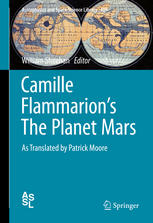

Most ebook files are in PDF format, so you can easily read them using various software such as Foxit Reader or directly on the Google Chrome browser.
Some ebook files are released by publishers in other formats such as .awz, .mobi, .epub, .fb2, etc. You may need to install specific software to read these formats on mobile/PC, such as Calibre.
Please read the tutorial at this link: https://ebookbell.com/faq
We offer FREE conversion to the popular formats you request; however, this may take some time. Therefore, right after payment, please email us, and we will try to provide the service as quickly as possible.
For some exceptional file formats or broken links (if any), please refrain from opening any disputes. Instead, email us first, and we will try to assist within a maximum of 6 hours.
EbookBell Team

4.4
22 reviewsCamille Flammarion (1842-1925) began his career at 16 as a human computer under the great mathematician U. J. J. Le Verrier at the Paris Observatory. He soon tired of the drudgery; he was drawn to more romantic vistas, and at 19 wrote a book on an idea that he was to make his own—the habitability of other worlds. There followed a career as France’s greatest popularizer of astronomy, with over 60 titles to his credit. An admirer granted him a chateau at Juvisy-sur-l’Orge, and he set up a first-rate observatory dedicated to the study of the planet Mars. Finally, in 1892, he published his masterpiece, La Planete Mars et ses conditions d’habitabilite, a comprehensive summary of three centuries’ worth of literature on Mars, much of it based on his own personal research into rare memoirs and archives. As a history of that era, it has never been surpassed, and remains one of a handful of indispensable books on the red planet.
Sir Patrick Moore (1923-2012) needs no introduction; his record of popularizing astronomy in Britain in the 20th century equaled Flammarion’s in France in the 19th century. Moore pounded out hundreds of books as well as served as presenter of the BBC’s TV program “Sky at Night” program for 55 years (a world record). Though Moore always insisted that the Moon was his chef-d’oeuvre, Mars came a close second, and in 1980 he produced a typescript of Flammarion’s classic. Unfortunately, even he found the project too daunting for his publishers and passed the torch of keeping the project alive to a friend, the amateur astronomer and author William Sheehan, in 1993. Widely regarded as a leading historian of the planet Mars, Sheehan has not only meticulously compared and corrected Moore’s manuscript against Flammarion’s original so as to produce an authoritative text, he has added an important introduction showing the book’s significance in the history of Mars studies. Here results a book that remains an invaluable resource and is also a literary tour-de-force, in which the inimitable style of Flammarion has been rendered in the equally unique style of Moore.